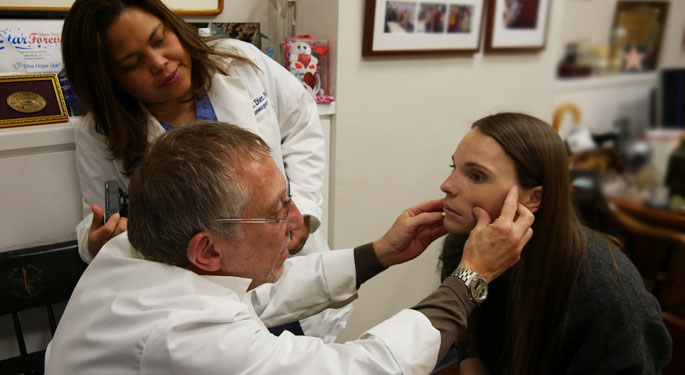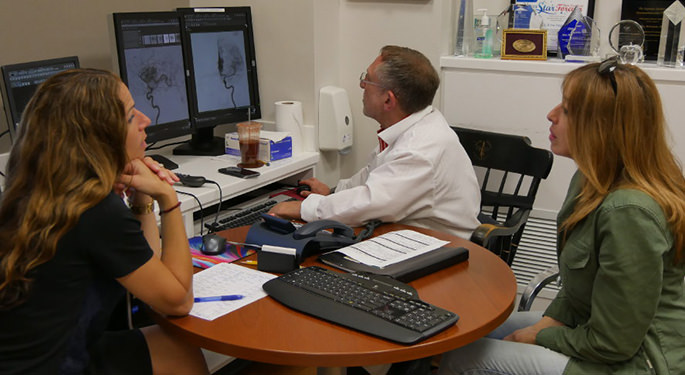

Vascular Malformations
We use the term “vascular anomalies” to describe a number of abnormalities that affect children and young adults. These anomalies look like a blemish or mass that may cause pain, swelling, or bleeding. Vascular malformations often result from abnormal development in blood vessels, lymph vessels, veins, and/or arteries. They are rare and complex and the experts at Mount Sinai have extensive experience diagnosing and treating these conditions.
Vascular malformations are usually present at birth, grow proportionally with the child, do not expand rapidly during infancy, and do not disappear. We sometimes see vascular malformations in older people, as blood flow increases through abnormal connections between arteries and veins. Vascular malformations can also come from fluid or blood accumulating in poorly formed veins or lymphatic channels. Vascular malformations can cause cosmetic deformities of the head and neck and can interfere with normal function in these areas. They also occur in other areas of the body and can cause pain, swelling, and bleeding.
Vascular malformations can be affected by hormonal changes during puberty and pregnancy and can result from fluid or blood accumulating in poorly formed veins or lymphatic channels. Vascular malformations may become apparent later in life as blood flow increases through abnormal connections between arteries and veins.
Most vascular malformations require treatment, to improve appearance and alleviate pain, swelling, and bleeding. Sometimes we can completely cure a vascular malformation. Many children and adults with vascular malformations achieve high levels of performance at school, in sports, and in their careers.
Combined Vascular Malformations
Many patients have vascular malformations that are made up of different types of abnormally formed vascular channels. One of the most common forms of combined vascular malformation is Klippel-Trenaunay syndrome, which involves malformations of the capillaries, lymphatics, and veins. If you have this condition, you may experience a variety of symptoms, depending upon the type and severity of the anomalies.
We work with specialists in pediatrics, pediatric orthopedics, plastic surgery, and endovascular surgery to develop the most appropriate treatment plan. When symptoms are related to malformations of the veins, endovenous laser and venous embolization, or sclerotherapy can be effective.
Treatment Options
Many vascular anomalies are very complex, so we take a collaborative approach to diagnosis and treatment, working with specialists in pediatrics, pediatric orthopedics, plastic surgery, and endovascular surgery. We use magnetic resonance imaging, to pinpoint malformations deep in the body.
The most common techniques are:
- Embolization is a minimally invasive procedure that closes the abnormal blood vessels from the inside using “glues” or particles. Sometimes we need to surgically remove the malformation or treat it with radiosurgery, a type of radiation. In these cases, we start with embolization, to shrink the malformation and reduce the risk of bleeding.
- Laser treatment can be effective for treating superficial venous malformations or the superficial component of a deep lesion. We use lasers that can reduce the bluish discoloration of the lining of the lip and mouth and the skin. We use a cooling device together with the laser to treat the vascular malformation through intact skin. We also combine laser treatment with surgery and sclerotherapy to successfully treat compound venous malformations.
We use lasers to treat lymphatic malformations, primarily small blisters on the surface of the tongue and the lining of the mouth. Since the lymphatic malformation can involve the entire thickness of the tongue, lasers may not cure the malformation, but can significantly improve your life, eliminating leaks of blood-stained fluid and allowing you to eat a wider range of foods. We administer this treatment under general anesthetic and typically repeat it every few years. After a patient heals, most or all of the blisters disappear. - Sclerotherapy helps us treat venous malformations and lymphatic malformations. We inject a substance through your skin into the malformation. We use a substance designed to irritate the wall of the vessel. This approach produces a blood clot, which effectively stops the flow of blood in the area. Inflammation of the inner wall then destroys the malformations, which the body replaces with scar tissue called sclerosis. It also eliminates the large disfiguring scars that come with surgery.
We have developed a treatment approach where we surgically remove the lesion within 24 to 48 hours after treating it with sclerotherapy. By using sclerotherapy first, we clot the lesion off and reduce the risk of severe blood loss during surgery. In addition, this two-step approach decreases the recurrence rate and the number of repeat procedures necessary to treat microcystic lesions. The results of this combined treatment have been excellent and we have been able to remove lesions that had previously considered inoperable.
- Surgery can be appropriate alone or after embolization or sclerotherapy. If the condition is extensive, we take only enough tissue to prevent recurrence, but avoid disfigurement. Sometimes we follow surgery with angiography scanning, to see if we need to perform embolization for more long-term stability.